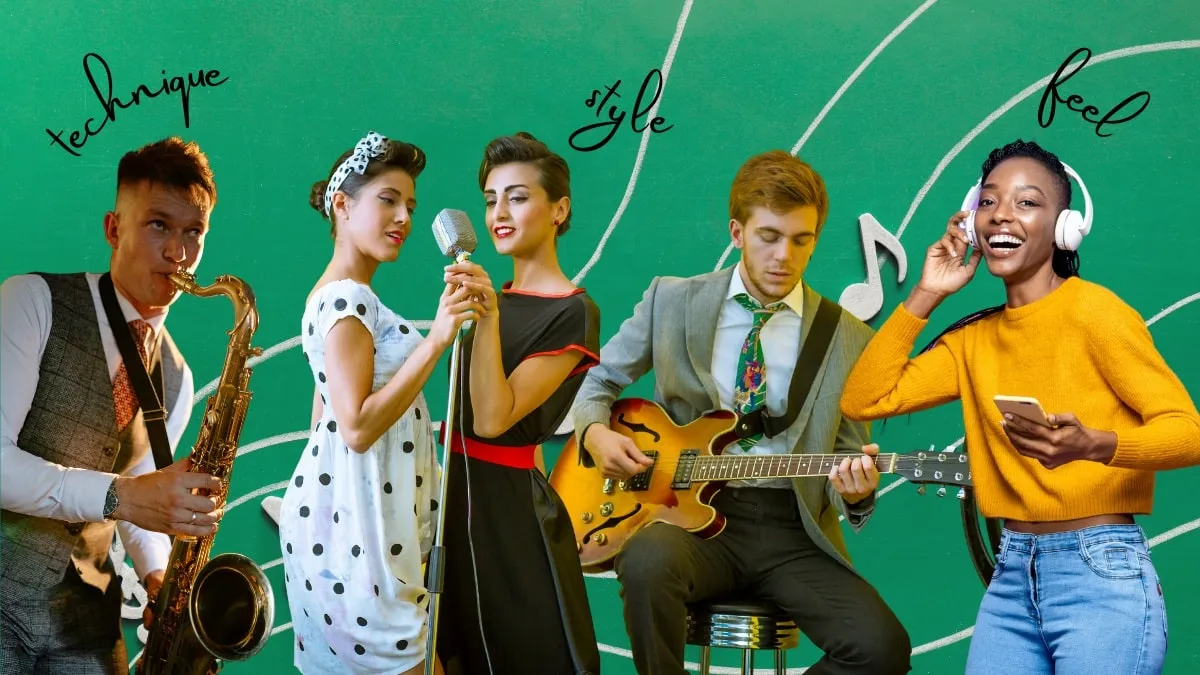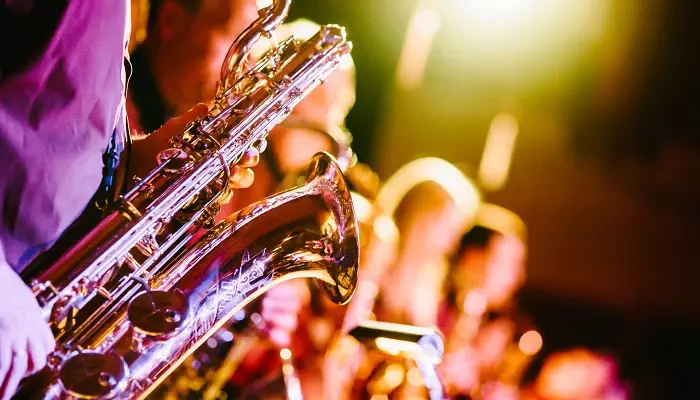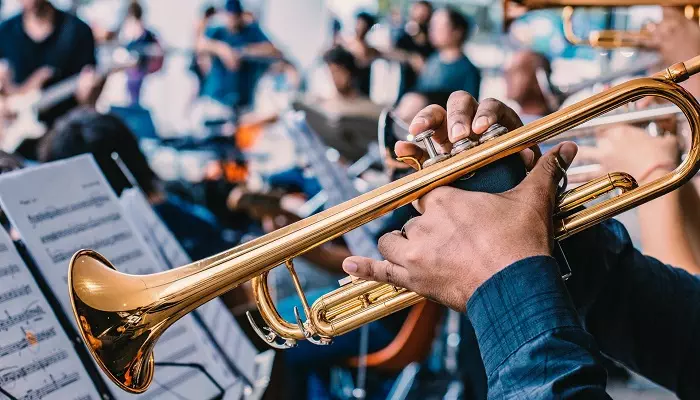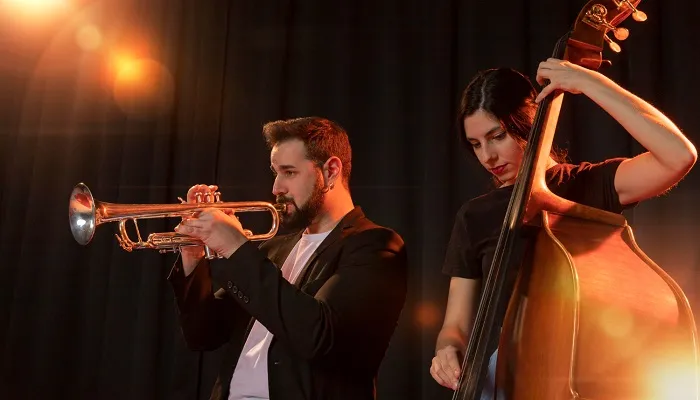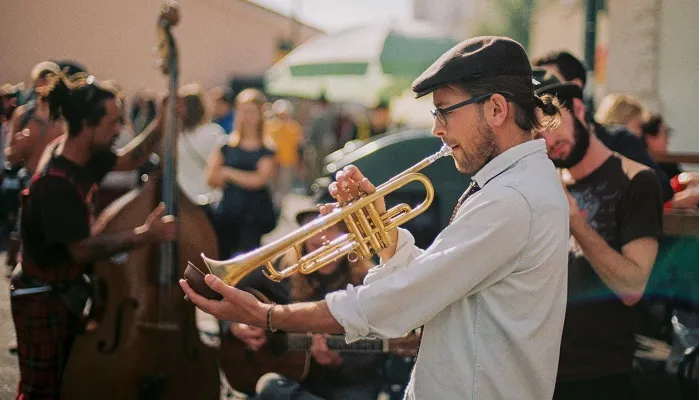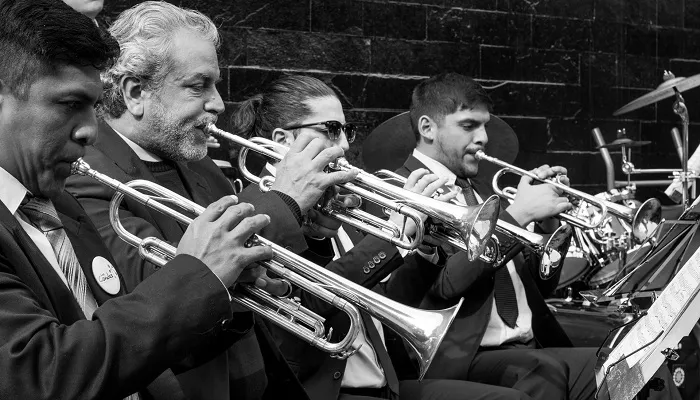When they hear the word “swing”, a lot of people have flashbacks of their playground days. But what if the question was asked in a musical context?
I found that almost everyone I know immediately thinks of old swing music accompanied by the fun swing dance. Now, they’re not wrong, but the answer to “what is ‘swing’ in music?” involves far more than a music style/dance.
In this article, I’ll be explaining all the possible meanings of the term “swing” in music and answering a bunch of common questions that always seem to pop up while discussing this topic. Let’s get started!
What does Swing Mean in Music?
In music, the term “swing” can refer to one of 3 things:
- A certain “feel” when the music elicits a visceral reaction from the listener such as nodding of the head or tapping of the feet.
- A lilting technique that involves a triplet subdivision of the beat.
- A style of jazz music that emerged in the 1930s and was particularly popular up until World War II.
What is Swing in Music?
As I mentioned above, the term “swing” can indicate many things, but in the music world, it has 3 main associations. Swing can be a “feel”, a way of performing, or a form of jazz music.
Below, I’m going to explain each of these meanings in more detail so you can really understand what swing is in music.
1. Swing “Feel”
The first definition of swing in the ‘Jazz in America’ glossary is “when an individual player or ensemble performs in such a rhythmically coordinated way as to command a visceral response from the listener (to cause feet to tap and heads to nod); an irresistible gravitational buoyancy that defies mere verbal definition”.
This definition pushes us towards the conclusion that swing in music can be interpreted as a “feel”. It’s like the term “groove” that’s also used to describe a rhythmic “feel” in a funk or rock context.
Unfortunately, this means that the concept of “swing” can be tricky to explain. After all, a lot of debate surrounds this term and what it describes.
Over the years, many jazz performers and musicians were asked to define “swing”. Some joked saying they’d prefer tackling Einstein’s theory, some called it “free speech in music”, some put it as simply a “matter of personal opinion”, and some slyly remarked that if you need to ask, then you’ll never know.
So perhaps the best answer to “what is swing?” is that you can feel it rather than explain it.
In ‘The World of Swing’, Stanley Dance discussed the concept of swing in the two first chapters of his book. He talked to several musicians who played such music, and the end description of swing was it being a kinetic quality to the music.
Swing was compared to flying where “take off” was a cue to fire up a solo. The rhythm of the melodies continued to flow between the beats, taking forms of articulation, inflection, and dynamics.
The book explains how swing lies in the music anticipating the beat as much as in the actual beat — just like the swing of a jump rope anticipating the jump.
The bottom line, “swing” is embedded in the music itself. It’s the electrifying feeling of anticipation that you can’t help but fall under its control, forcing your body to respond in a way that matches the rhythmic pulse of the music.
2. Swing “Rhythm”
The second definition of swing in the ‘Jazz in America’ glossary is “a way of performing eighth notes in which downbeats and upbeats receive approximately 2/3 and 1/3 of the beat, respectively, providing a rhythmic lilt to the music”.
From this definition, it’s clear that swing is a technique of playing music with the purpose of lilting. So, allow me to elaborate on “swing” as a “rhythm”.
Typically, jazz is played with a swing rhythm, also known as swung rhythm and swung notes (this is not to be confused with the jazz music style of ‘Swing’ which we’ll be talking about in a bit). When music is not played swing, it’s called straight.
Although listening is the best way to learn the difference between a swing rhythm and a straight rhythm, I’ll try to explain it as simply as possible.
In a straight rhythm where you’re playing 8th notes in 4/4 time (which means two notes per beat), you play the first 8th note on the beat and the second 8th note precisely halfway between the two beats.
So, if you’re playing a straight rhythm at 60 bpm (that’s 1 beat per second), you’d play it as follows:
- 1st 8th note — 0 secs
- 2nd 8th note — 0.5 secs
- 3rd 8th note — 1.0 secs
- 4th 8th note — 1.5 secs and so on.
But in a swing rhythm, you play the first 8th note on the beat and slightly delay the second 8th note. Played at 60 bpm, it’d go as follows:
- 1st 8th note — 0 secs
- 2nd 8th note — 0.66 secs
- 3rd 8th note — 1.0 secs
- 4th 8th note — 1.66 secs and so on.
As you can tell from the values above, the pulse is divided unequally in swing rhythm, alternating between long and short durations in certain subdivisions (usually either 8th note or 16th note subdivisions).
As such, the first note of each pair is often regarded to be twice as long as the second, producing a triplet feel. In practice, however, this ratio is more flexible and subtle.
In traditional jazz, swing rhythm is customarily applied to 8th notes. In funk, jazz-rock, as well as a bunch of other genres, swing rhythm is mostly applied to 16th notes.
Instruments
In a swing rhythm section, different instruments express swing in different ways, and with the development of the music, the ways these instruments expressed swing rhythm also evolved.
If we trace the timeline of swing music back to its early development, we’ll hear musicians often playing the bass with lead-in note couplets, usually paired with a percussive sound.
Later on, the lead-in beat was no longer played, but it’d been incorporated into the physical rhythm of the bass player to help maintain a solid beat.
Following the same steps, guitarists played the guitar with the lead-in note incorporated in their physical rhythm but the note itself was inaudible.
As for the piano, musicians played it with a variety of techniques for swing rhythm. For example, the chord patterns played in the rhythm of a dotted-eight—sixteenth couplet were typical elements of boogie-woogie swing playing.
Additionally, there was the swing bass left-hand technique that used a bass note on the first and third beats, followed by a mid-range chord to highlight the second and fourth beats. Here, the lead-in notes were also inaudible, expressed in the movement of the left arm instead.
What’s more, the swing bass piano introduced the anticipatory role of the first and third beats to stress the second and fourth beats in two-beat figures.
Later, the role of the piano in the ensemble changed to emphasize accents and fills as swing music developed.
3. Swing “Style”
The third and final definition of swing in the ‘Jazz in America’ glossary is “a stylistic term to designate a jazz form that originated in the 1930s with the advent of the big bands (as in Swing Era)”.
Any guesses as to what that means? Yes, you got it right — this definition refers to the most common answer that people think of when asked “what is ‘swing’ in music?”; swing as a “style” of jazz.
Origin and Popularity
Swing music originated back in the 1930 and grew popular until around World War II. Big bands were the chief performers of this style of music (more on this below), which spread nationwide in dance halls and reached even broader audiences over the radio and on records.
The most probable explanation for the popularity of swing music is that it came about when the country was going through a hard time. Its intensity and vigor allowed people to experience pleasure and freedom during the tough period of the Great Depression.
The money troubles caused Americans to suffer, but dancing to swing music was an effective way for people to blow steam and forget their problems. This is why swing music became a symbol of joy and ease in the 1930s.
Big Bands
When discussing the swing style of music, big bands are bound to come up. You see, before the 1930s, musicians performed jazz in small ensembles of instruments. These instruments typically included a trumpet, trombone, clarinet, piano or banjo, bass or tuba, and drums.
In this sectionalized approach, each instrument played a certain role in the ensemble. There was a set melody, but parts were often created on the spot.
Swing music adopted the same approach but in big bands. So instead of a small ensemble, sections were consisting of 3 or 4 trumpets, 3 or 4 trombones, 5 saxophones/clarinets, a piano, a guitar, a bassist rather than tuba player, and of course, drums.
When it came to arrangements of swing bands, composers often made them in large parts that consisted of simple, repeated material also known as “riffs”. These riffs went back and forth between contrapuntal lines and deep unison rhythms.
As with jazz, improvisation was a highlight in swing performances where soloists would play while the rest of the band stopped playing or played arranged background lines, except for the rhythm section.
What is the difference between Jazz and Swing?
All this talking about swing music brings about a certain hot topic: the difference between jazz and swing.
Aside from jazz fanatics and serious musicians, a lot of people often wonder about this, and understandably so — I mean, things can get pretty confusing when trying to tell apart jazz from ‘swing’. This is especially true because of the dozens of genres and subgenres that essentially sound quite similar.
So, if both music styles have a “jazzy” feel, what makes them different? This makes you question why sometimes jazz and swing are considered two separate genres, while at other times (like I mentioned above) jazz is thought of as the parent genre from which swing is rooted.
Well, the prevailing theory is that swing music was simply the natural evolution of jazz music during the 1920s and 1930s when a positive sound was needed to help people overcome difficult times.
To better explain the differences between jazz and swing, we need to consider these music styles in a cultural as well as a musical light.
Origins
If you’re still in the grey zone about all this, I can tell you one thing for sure: jazz was here first before the swing genre.
New Orleans is the birthplace of jazz music, but it didn’t just appear overnight as is the case with any genre of music. Jazz is known to be the product of merging folk songs and hymn music.
The cultural roots of jazz music were deeply influenced by the West African heritage of its first protagonists. It combined elements from the music of marching bands with ragtime.
Traditional jazz emerged at the beginning of the 20th century. It was later called Dixieland in the southern states of the United States.
The cornet or trumpet, trombone, and clarinet were the lead instruments in early jazz. To add rhythm and harmony, banjo, tuba, or drums were thrown into the mix.
In traditional jazz, you’ll hear the lead instrument playing the main melody and then improvise on it, while the rest of the instruments will produce their own variations of the main melody. This is how the distinct sound of jazz is created.
In the 1920s, jazz music made its way from the streets to the speakeasies and dance halls. As the sound of jazz evolved, piano and double bass were often added.
Evolution
As I said earlier, swing music is the result of the natural evolution of jazz with the ending of the 1920s and the start of the 1930s. The goal was to make jazz more suitable for the dance floor to appeal to a broader audience.
This is why the rhythm section attracted more attention from musicians. They began to place more emphasis on the double bass, piano, and drums. However, the “front line” of a swing band remained the traditional trumpet, trombone, clarinet, and saxophone.
A lot of swing bands had standout individual instrumentalists in leadership positions, but the beauty of swing music was that the focus was almost always on the whole band as a unit. It helped that swing bands had a large number of members, so they required more regimentation.
As a result, swing bands worked from written arrangements and compositions as opposed to jazz musicians who rarely played from written material. Improvisation was left to the lead instrumentalists to be done over the support of the band.
Over time, swing music became synonymous with lively, cheerful dancing. Still, to our day, not many music genres can get a dance floor busy and moving so quickly the way swing music can.
How can You Tell if a Song is ‘Swing’?
To help you determine whether a certain song belongs to the swing music genre, here are a few identifying characteristics to check for:
- Technique — as I’ve established above, big bands played swing music, which is why members had to rely on written-out scores and arrangements. To keep their sound interesting, band leaders incorporated various arrangement techniques such as:
- Tutti – where all horns play a melodic line in harmony.
- Soli – where one section plays a melodic line in harmony.
- Shout Chorus – a climactic tutti section at the end of the arrangement.
- Riffs – these are repeated short melodic and/or rhythmic patterns such as Bluesy Riffs or Call and Response Riffs.
- Solos – where a single person improvises behind a simple harmonic background.
- Harmony — swing music involved the use of simple chords to create a clear homophonic texture.
- Melody — swing music featured clear, emotional, and memorable melodies
- Rhythm — swing music presented a solid beat with an intense dance groove. In other words, it just swung.
- Hot vs Sweet style — there were generally 2 different styles of swing music:
- Sweet swing music (artists like Glenn Miller) – this style was characterized by less improvisation and more restraint. It was a bit slower with a slight swing feel to fit the taste of the white upper-class dinner parties.
- Hot swing music (artists like Duke Ellington) – compared to sweet swing, this style was a lot more daring, free, and experimental. It had a faster pace with longer improvisation segments, more intense rhythmic drive, and a sharp blues feeling.
